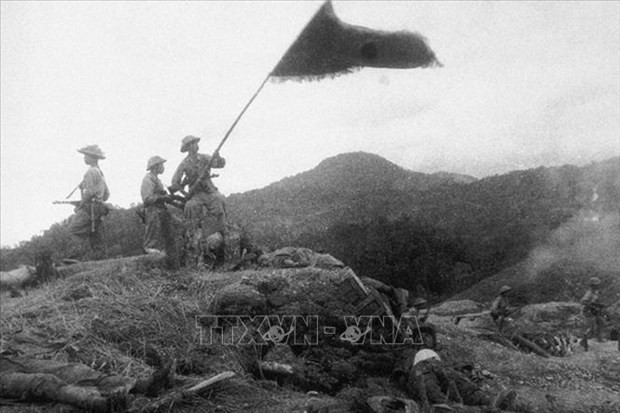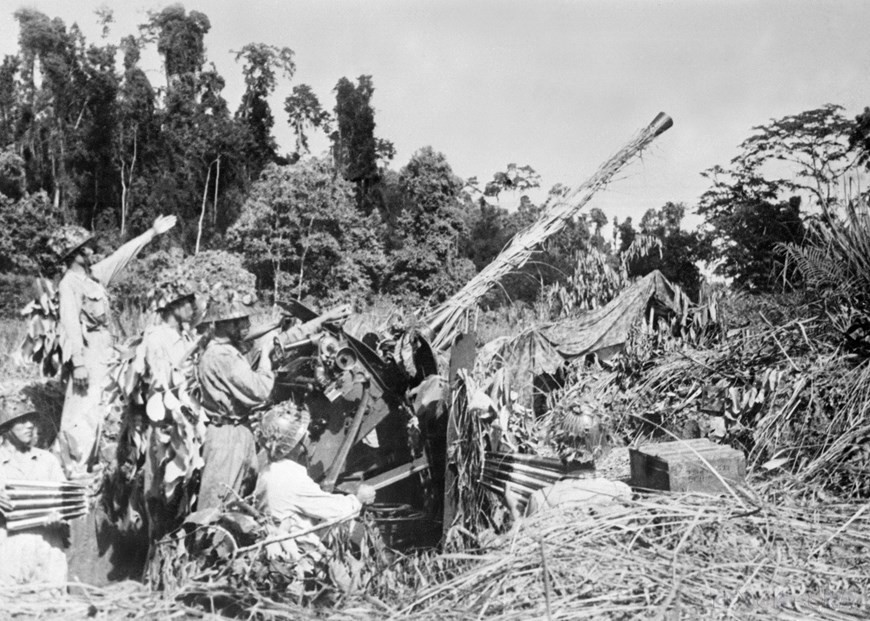The great victory mentioned above stems from the heroic nation’s historical tradition. Under the Party’s leadership, the bravery, intelligence, and strength of the Vietnamese people are affirmed by the golden milestone of history, the Dien Bien Phu Victory – a vivid symbol of the power of the people’s war during the Ho Chi Minh era.
Vietnamese people’s resistance against French colonialism was one of national freedom and justice, and the power of the people’s war was heavily captivated. The Dien Bien Phu campaign was distinguished by the mobilization and organization of the entire people’s forces to fight the enemy, with the people’s armed forces serving as the foundation for a comprehensive, all-people war.
 |
| Vietnamese soldiers fly the flag of victory on the Him Lam fortification that they occupied in the opening battle of the Dien Bien Phu Campaign on the afternoon of March 13, 1954. (File photo: VNA) |
The people’s war policy, as defined by the Vietnamese Party and President Ho Chi Minh, is compatible with the nation’s fight tradition; in a “heaven and earth net” battle, the entire country fought the enemy, each citizen a soldier, and each town a fortress. Everywhere the enemy went, they were defeated and fought with every weapon. A typical example was President Ho Chi Minh’s Appeal for National Resistance which read: “To any man, woman, the old or the young, regardless of religions, parties, or ethnicities; if you are Vietnamese, you must stand up and fight the French to save our Fatherland. Those who have guns, use guns. Those who have swords, use swords, and those who do not have swords, use pickaxes, spades, or clubs. Each individual must make efforts to fight against the French colonialists to save the country.”
Due to the disparity between forces, particularly in terms of economic and military capability, to ensure a successful people’s war, the Vietnamese Party was eager and steadfast in carrying out the motto of both resistance and national construction. As a result, the potential of the people’s war had steadily increased, laying the groundwork for the Party, people, and army of Vietnam to win the Winter-Spring War (1953-1954), culminating in the Dien Bien Phu Victory.
The historic event created a strong and extensive people’s armed forces of three categories, which will serve as the foundation for the entire population to combat the opponents. Thoroughly understanding the principles of Marxism-Leninism on armed struggle, and organizing a military-style proletarian army and the resistance war against the French colonialists, the Vietnamese Party placed a high value on building three types of armed forces, namely the main army, the local army, and strong and large guerrilla warfare. During the Winter-Spring War (1953-1954), the main force evolved at the regimental level, and by the Dien Bien Phu campaign, Vietnam had added an artillery and air defense regiment. With such impressive growth, the country had the opportunity to conduct large-scale, decisive strategic offensive efforts.
After analyzing and correctly assessing the situation, the Politburo of the Party Central Committee and the General Military Commission of Vietnam resolved to “concentrate the majority of our battle-hardened main forces on the Dien Bien Phu Front and to mount attacks against the enemy’s elite forces in their most powerful fortified camp in Indochina”. In this strategic decisive combat, Vietnam assembled the main army troops to participate, including three infantry divisions (308, 312, and 316), the 351st Artillery-Engineer Division, one regiment under the 304 Division, and a number of military units. The campaign is supported by a considerable force, including 6,280 transport cars, 21,000 bicycles, and 251,000 citizens.
The reality of the Dien Bien Phu campaign demonstrates that the Vietnam People’s Armed Forces are tightly and widely organized; as a result, its army and people have performed extraordinary miracles, particularly when Vietnam changed the motto “fight quickly, win quickly” to “fight firmly, advance firmly,” which caused the enemy to go from one surprise to another. On May 7, 1954, Vietnam won the Dien Bien Phu campaign.
Additionally, the Dien Bien Phu Victory strengthen the forces and stance of the Vietnamese people’s war. To prepare for the key strategic fight, with resolve and courage, the strength to unify the army and people, and tens of thousands of citizens and workers, young volunteers, and engineering soldiers, they energetically and urgently accomplished a seemingly impossible amount of work. In just over three months (December 1953 – March 1954), Vietnam completed the repair and opening of Road No. 41, Road No. 13, and the road from Tuan Giao to Dien Bien Phu, the primary motorized transport routes with a total length of almost 300 km.
Throughout the Dien Bien Phu war, Vietnamese people “contributed 25,560 tons of rice, 226 tons of salt, 1,909 tons of food, 26,453 civilian workers, 20,991 bicycles, 1,800 pieces of bamboo, 756 rudimentary vehicles, 914 horses, carts, and 3,130 boats.” Never before had our people contributed effort that much, as affirmed by General Vo Nguyen Giap.
 |
| Anti-aircraft artillery fights heroically and achieves remarkable feats. The force not only protected the skies and supported the infantry, but also played a crucial role in blocking air support for the French Army. (Photo: VNA files) |
Another reason for the success was the active and effective battlefield coordination within the Dien Bien Phu campaign. Before the Dien Bien Phu campaign, Vietnam gradually destroyed Nava’s military plans through the Party Central Committee’s correct and creative resistance policy, led by Chairman President Ho Chi Minh. Vietnamese army prevailed in the attacks on Gia Lam airport (March 4, 1954) and Cat Bi airport (March 7, 1953) making a great splash and boosting its army’s and people’s combat spirit across the board.
In addition, when the key strategic fight occurred, battlefields across the country eagerly “shared fire” to contend with Dien Bien Phu.
When the Dien Bien Phu campaign began on March 13, 1954, the Southern Department’s Central Committee directed all efforts to quicken the pace of attack to organize the main battlefield. Inter-regional and provincial sub-regional main force battalions worked with local soldiers to target enemy rear areas in provinces as well as major traffic arteries such as National Highways No. 1, No. 13, No. 14, and railroad lines, namely Saigon-Phan Thiet; Saigon-Loc Ninh.
On March 15, 1954, the 4th Inter-Region Command authorized Binh-Tri-Thien province to actively coordinate the Dien Bien Phu campaign by hitting hard on roads, vigorously resisting raids, and resisting conscription to strain the enemy.
In the South Central region, the Inter-regional Party Committee and Inter-Regional Command No. 5 advocate focusing development forces on the Southern Central Highlands, attacking strongly on Route No. 14, Route No. 7, especially on Route 19, and at the same time promoting guerrilla warfare behind the enemy’s back.
In the North, in coordination with the Dien Bien Phu battlefield, the army and people of Hai Duong and Hung Yen provinces launched many “general attacks” to attack Road No. 5 and the enemy’s strategic transportation routes. In Hanoi, implementing the policy of promoting enemy mobilization work of the City Party Committee, at Bach Mai airport, in just five days, up to 1,200 soldiers deserted.
The results of coordinated warfare are significant, making it difficult for the enemy to replenish rescue forces, allowing our forces to concentrate on tightening the fire siege and defeating the opponents in Dien Bien Phu.
Currently, in the context of worldwide and regional conditions with many complex and difficult



